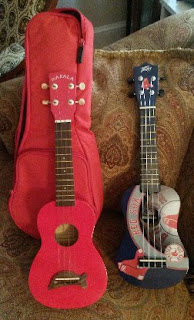[This is a draft. It's a pretty good draft, but it is a draft nonetheless. It may undergo some revision before being finalized, but I don't expect it to change much.]
As a hobbyist guitar player, whenever I came across a diminished chord I'd skip it. Six strings and a chord that requires 4 fingers in a cramped position is something I did not need, thank you.
That said, the sound of the diminished chord is really nice. A ukulele has but four strings and the position isn't that bad when there are only four strings. While there are many ways to form the same chord, it's easy to argue that there are only 3 diminished chords, all of the same shape but on different frets. Each one of the diminished chords can be named by any of the four notes in it. So, for example, (0,1,0,1) contains the notes G, C#, E, Bb so it can be called Gdim, C#dim, Edim, Bbdim.
| Chord |
Notes |
\
 |
G |
C#/Db |
E |
A#/Bb |
 |
G#/Ab |
D |
F |
B |
 |
A |
D#/Eb |
F#/Gb |
C |
What could be simpler? But, if it's so simple, why can't I remember it?!
The above table is correct. It has pictures of the chords and their notes. However, having thought about diminished chords and being frustrated by them for some time, I have now come to appreciate that, to master diminished chords, it is essential to know the first three frets of the fretboard as if by rote. As a result, I've become more enamored of this second table that displays the fret board:
| Fret |
Notes |
0
(nut) |
G |
C |
E |
A |
| 1 |
G#/Ab |
C#/Db |
F |
A#/Bb |
| 2 |
A |
D |
F#/Gb |
B |
| 3 |
A#/Bb |
D#/Eb |
G |
C |
It is even better, as we shall see, when four notes are removed from the display
| Fret |
Notes |
0
(nut) |
G |
|
E |
|
| 1 |
G#/Ab |
C#/Db |
F |
A#/Bb |
| 2 |
A |
D |
F#/Gb |
B |
| 3 |
|
D#/Eb |
|
C |
As was already mentioned, all that one has to do to obtain a particular diminished chord is move the diminished shape so that it covers the note naming the chord. For example, to obtain Bdim move the shape so that a finger covers a B somewhere. There's
| string |
fret |
chord |
1
|
2 |
1212 |
| 2 |
7 |
7878 |
| 3 |
11 |
10,11,10,11 |
4
|
4 |
4545 |
Notice that the diminished chord repeats itself every three frets. That is, if (f,f+1,f,f+1) is a particular diminished chord, then so is (f+3,f+4,f+3,f+4), where 'f' is a certain fret number.
Leaving the C and A out of the fretboard diagram was a breakthrough of sorts for me. Like most ukulele players, I've drilled it into myself that the ukulele is tuned gCEA, so, when looking for a C, I automatically think of the open third string. However, that doesn't work for diminished chords because there is no way to fret the first and third strings below the nut! 'C' is first string, third fret. Similarly, 'A' is fourth string, second fret. It is no accident that 'C' and 'A' are emboldened in the table.













